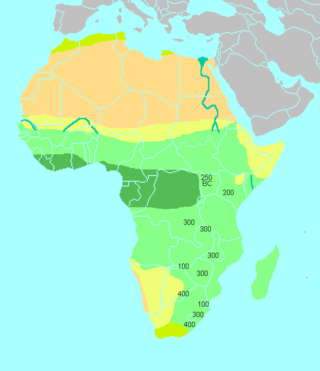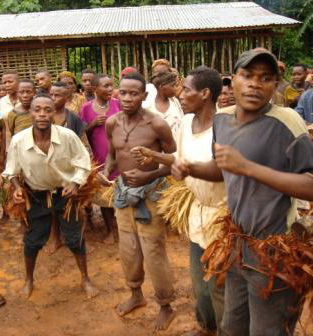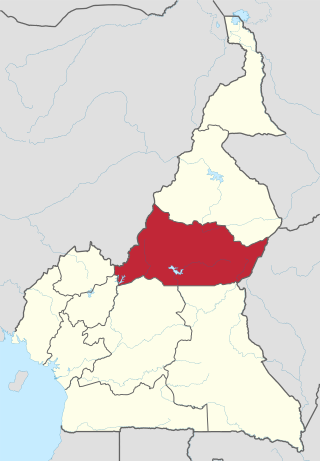Related Research Articles

The Bantu languages are a language family of about 600 languages that are spoken by the Bantu peoples of Central, Southern, Eastern and Southeast Africa. They form the largest branch of the Southern Bantoid languages.

Cameroon, officially the Republic of Cameroon, is a country in Central Africa. It shares boundaries with Nigeria to the west and north, Chad to the northeast, the Central African Republic to the east, and Equatorial Guinea, Gabon and the Republic of the Congo to the south. Its coastline lies on the Bight of Biafra, part of the Gulf of Guinea and the Atlantic Ocean. Due to its strategic position at the crossroads between West Africa and Central Africa, it has been categorized as being in both camps. Its nearly 27 million people speak 250 native languages and English or French or both.

The Bantu expansion is a hypothesis about the history of the major series of migrations of the original Proto-Bantu-speaking group, which spread from an original nucleus around Central Africa. In the process, the Proto-Bantu-speaking settlers displaced, eliminated or absorbed pre-existing hunter-gatherer and pastoralist groups that they encountered.

The Baka people, known in the Congo as Bayaka, are an ethnic group inhabiting the southeastern rain forests of Cameroon, northern Republic of the Congo, northern Gabon, and southwestern Central African Republic. They are sometimes called a subgroup of the Twa, but the two peoples are not closely related. Likewise, the name "Baka" is sometimes mistakenly applied to other peoples of the area who, like the Baka and Twa, have been historically called pygmies, a term that is now considered derogatory.

The Maka or Makaa are a Bantu ethnic group inhabiting the southern rain forest zone of Cameroon. They live primarily in the northern portions of the Upper Nyong division of Cameroon's East Province. Major Maka settlements include Abong-Mbang, Doumé, and Nguélémendouka. Some Maka villages lie over the border into the Centre Province, as well.
The Njyem are an ethnic group inhabiting the rain forest zone of southern Cameroon and northern Republic of the Congo. In Cameroon, the Njyem live along the road running south from Lomié, passing the government center of Ngoyla and going as far south as Djadom. From there, footpaths extend to Souanke in northern Congo. Their territory lies south of the Nzime people and north of the Bekwel, both related groups. Ngoyla is the largest Njyem center. Souanke is equally important, but is a center shared with the Bekwel. They speak Njyem ("NJY"), one of the Makaa–Njem Bantu languages.
The Badwe'e are an ethnic group inhabiting the rain forest zone of southeastern Cameroon. They recognize themselves as the descendants of Edwe'e, the youngest son of Koo and the brother of Njeme and Nzime. The Badwe'e live south of Messaména in the East Province in a region south of the Bekol and both north and west of the Nzime. Their territory includes much of the northern and western border of the Dja Biosphere Reserve. They speak a dialect of Koozime, together with the Nzime.
The Beti-Pahuin are a Bantu ethnic group located in Center region of Cameroon. Though they separate themselves into several individual clans, they all share a common origin, history and culture. Estimated to be well over 8 million individuals in the early 21st century, they form the largest ethnic group in central Cameroon and its capital city of Yaounde. Their Beti languages are mutually intelligible.

The Bamiléké are a group of 90 closely related peoples who inhabit the Western High Plateau of Cameroon. According to Dr John Feyou de Hapy, Bamiléké means people of faith.

The Fang people, also known as Fãn or Pahouin, are a Bantu ethnic group found in Equatorial Guinea, northern Gabon, and southern Cameroon. Representing about 85% of the total population of Equatorial Guinea, concentrated in the Río Muni region, the Fang people are its largest ethnic group. The Fang are also the largest ethnic group in Gabon, making up about a quarter of the population.
The Mungo (Moungo) are an ethnic group of the Republic of Cameroon. Along with the other coastal peoples, they belong to the Sawa ethnic groups. The Mungo have historically been dominated by the Duala people, and the two groups share similar cultures, histories, and claims of origin.

The Bamboko are a Bantu ethnic group of the Republic of Cameroon. They are part of the Sawa ethnic groups, those who live on the coast.

The Tikar are a Central African people who inhabit the Adamawa Region and Northwest Region of Cameroon. They are known as great artists, artisans and storytellers. Once a nomadic people, some oral traditions trace the origin of the Tikar people to Northern Nigeria, the Sudanian savanna, or the Sudan. Such ethnic groups were referred to in the 1969 official statistics as "Semi-Bantus" and "Sudanese Negroes." They speak a Northern Bantoid language called Tikar. One of the few African ethnic groups to practice a monotheistic traditional religion, the Tikar refer to God the Creator by the name Nyuy.They also have an extensive spiritual system of ancestral reverence.

The Bakole are a Bantu ethnic group of the Republic of Cameroon. They belong to the Sawa, or Cameroonian coastal peoples. The Bakole speak a language of the same name.
The Nzime are a Bantu ethnic group inhabiting the rain forest zone of southeastern Cameroon. The Nzime live along the road running south of Abong-Mbang, through Mindourou and Lomié, and forking to Zoulabot and Zwadiba. Their territory lies south of the Koonzime in Djaposten, east of the Badwe'e, north of the Njyem, and west of the Konabembe people, all related groups. The Nzime speak the Nzime dialect of Koonzime ("OZM"), one of the Makaa–Njyem Bantu languages.
Tikar is a Northern Bantoid, semi-Bantu language that is spoken in Cameroon by the Tikar people, as well as by the Bedzan Pygmies, who speak their own dialect of the language. A recent hypothesis by Roger Blench suggests that the Tikar language could be a divergent language in the Niger-Congo language family with an uncertain origin.

The Bantu peoples are an ethnolinguistic grouping of approximately 400 distinct native African ethnic groups who speak Bantu languages. The languages are native to 24 countries spread over a vast area from Central Africa to Southeast Africa and into Southern Africa. There are several hundred Bantu languages. Depending on the definition of "language" or "dialect", it is estimated that there are between 440 and 680 distinct languages. The total number of speakers is in the hundreds of millions, ranging at roughly 350 million in the mid-2010s. About 60 million speakers (2015), divided into some 200 ethnic or tribal groups, are found in the Democratic Republic of the Congo alone.
Mahongwe is an undocumented and threatened Bantu language spoken in Gabon. The Mahongwe language is a language spoken by the Mahongwe people, belonging to the Bantu ethnic group, who mainly reside in the central Gabon region. It is one of several Bantoid languages spoken in the Central African region.
The Oroko are an ethnic group in Cameroon. They belong to the coastal Bantu group, widely known as Sawa, and primarily occupy the Ndian and Meme divisions of the Southwest Region of Cameroon. The people predominantly speak Oroko, English, and Cameroon Pidgin English. The Oroko are related to several ethnic groups in Cameroon's coastal areas, with whom they share a common traditional origin, and similar histories and cultures. These include the Bakweri (Kwe), Bakole, Duala, Ewodi, the Bodiman, the Pongo, the Bamboko, the Isubu, the Limba, the Mungo, and the Wovea.
References
- ↑ "Definition of SEMI-BANTU". www.merriam-webster.com. Retrieved 2022-05-14.
- ↑ PRICE, DAVID. “WHO ARE THE TIKAR NOW?” Paideuma, vol. 25, 1979, pp. 89–98. JSTOR, JSTOR 23076439. Accessed 2 Dec. 2022.
- ↑ Blench, Roger (2011). "'The membership and internal structure of Bantoid and the border with Bantu" (PDF). Berlin: Humboldt University. p. 16.
- Neba, Aaron (1999). Modern Geography of the Republic of Cameroon, 3rd ed. Bamenda: Neba Publishers.